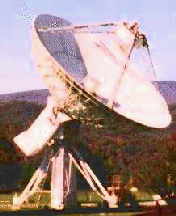 Station Command Files
Station Command Files
The realtime control task, DISPATCH, sets the station state
based on input command files. These command files
are ascii files that are readable (and editable).
Most of the command files are created "by-hand" by the
programmers and engineers.
The top level files are generated by the offline program,
SCHEDCO.
The top level command file "includes" several lower level
command files that setup all station hardware.
A few important features of command files should be noted:
- Comments
- Command file lines beginning with # are assumed to be
comments. Command files should contain a short description
at the beginning and a HISTORY of file edits.
- lines oriented
- Commands in command files are all contained on a single line
which has 4 parts.
- date (optional)
- The date of exection of a command.
if no date is specified, the command is assumed to be executed
on the current date.
- time (optional)
- The time of exection of a command. If no time or
date are specified, then the command is executed immediately.
- command name
- Each DISPATCH command has a name indicating the hardware device
or software subsystem being set to the desired state by the command.
- KEYWORD=VALUE (optional)
- Commands have zero, one or more arguments in KEYWORD=VALUE
form describing the desired states. For example to turn
the write head on the first of two tape drives, the DISPATCH
command is TAPE DRIVE=1 WRITE=ON.
- INCLUDE
- A command file may include other command files. If a command
file is included, then all commands in the included file are
executed before the next command in the original file is executed.
- DEFINE
- VALUEs may be assigned DEFINEd values. This feature allows
redimentary argument passing between top level command files
and included command files. This feature is used to pass
a particular satellite orbit prediction file name to a general
purpose command file.
Special Command Files
An number of command files are frequently used in the system,
and these command files are described below:
- start.cmd
- At system initialization, this command file is run
to set all station hardware in the default state. The antenna
breaks are set, but no antenna motion is commanded.
- idle.cmd
- Stow the antenna and indicate that the station is not
active, but otherwise leave the station hardware unchanged.
- vsop commands
The three main
command files for three phases of VSOP tracking pass are:
- vsopStart.cmd
- Set up all station hardware in the proper mode for
VSOP/HALCA. Satellite tracking starts, and the transmitter
warm-up is started. This action is started 10 minutes before
tracking is scheduled to begin.
- vsopLink.cmd
- Command transmitter on and start residual phase processing.
The ACQUIRE procedure is initiated, which resets the
formatter clock and records DECODER times.
The transmitter is commanded on a few seconds before the
scheduled link time.
- vsopUnlink.cmd
- Turn off transmitter and stop data recording.
- trackEnd.cmd
- At the end of tracking any satellite, the phase residual data
must be transfered offline and the system restored to the idle
state.
- satsimTest.cmd
- The main diagnostic test mode of the system is commanded using
the satellite simulator. This command file includes other
files to turn on the satellite simulator, place the decoder in
test data mode and record test phase residual data.
- moveTapeBegin.cmd and moveTapeEnd.cmd
- Commands to pre-position a tape before a tracking pass.
- tapeDrive0.cmd tapeDrive1.cmd, tapeDrive2.cmd and tapeDrive3.cmd
- Select which VLBA tape drives will be used during the tracking
pass. 0==none, 1=1, 2=2 and 3=both tape drives.
- tape1601.cmd ... tape1628.cmd
- Command files to initiate data recording in 16 track
mode to one of 28 different data recording positions.
- calmesAuto.cmd and calmesEnd.cmd
- Command files to start and stop calibration tone extraction
in the formatter.
The satellite simulator test command file is listed below:
#Dispatch command file to run satellite simulator in long loop mode
#History
# 97jun06 GIL add VSOP_SC commands for testing
# 97mar23 GIL initial version
# pass prediction and output residual file names
DEFINE ORBITFILE=zen2.orb
DEFINE PHASEFILE=satsimTest.phr
#stop all known tasks
TRACK STOP
TWT STOP
REGION STOP
SURVEY STOP
#
MESSAGE BEGIN LINK to satsim in 1 minute
PROGRAM SNAME=SATSIM
PROGRAM RA=11H47M13.312S DEC=+01D23'55.233 EPOCH=2000
VSOP_SC OBSCOD=VT801
VSOP_SC PWRNSPEC=SYNTHB
INCLUDE FILE=tapeDrive0.cmd
INCLUDE FILE=vsopStart.cmd
# now reset the modules needed for satellite simulator
INCLUDE FILE=satsimStart.cmd
#load calibration tones into decoder for extraction
INCLUDE FILE=setDecTestTones.cmd
#get decoder input from reciever
DECODER INPUT=REC
INCLUDE FILE=calmesAuto.cmd
INCLUDE FILE=vsopLink.cmd
MESSAGE Satellite simulator test: 15m.
WAIT PAUSE=15m
INCLUDE FILE=calmesEnd.cmd
INCLUDE FILE=vsopUnlink.cmd
INCLUDE FILE=trackEnd.cmd
The latest copy of the DISPATCH command syntax is
specification is kept
on-line .
Return to the Station Software Guide.
The National Radio Astronomy Observatory
(NRAO)
is a facillity of the
National Science Foundation
operated under cooperative agreement by
Associated Universities, Inc.
glangsto@nrao.edu Last update: 97 July 3
 Station Command Files
Station Command Files Station Command Files
Station Command Files